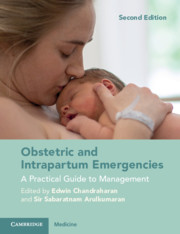Book contents
- Obstetric and Intrapartum Emergencies
- Obstetric and Intrapartum Emergencies
- Copyright page
- Contents
- Contributors
- Preface
- Preface to the First Edition
- Acknowledgements
- Section 1 General Principles
- Section 2 Algorithms for Management of the Top Five ‘Direct Killers’
- Chapter 3 Management of Deep-Vein Thrombosis and Pulmonary Embolism
- Chapter 4 Management of Severe Preeclampsia and Eclampsia
- Chapter 5 Management of Massive Obstetric Haemorrhage
- Chapter 6 Management of Septicaemia and Septic Shock Antepartum, Intrapartum and Postpartum
- Chapter 7 Management of Amniotic Fluid Embolism
- Section 3 Intrapartum Emergencies
- Section 4 Postpartum Emergencies
- Section 5 Medical and Surgical Emergencies During Pregnancy
- Section 6 Anaesthetic Emergencies During Pregnancy
- Section 7 Neonatal Emergencies and the Management of Immediate Neonatal Problems
- Section 8 Management of Anticipated and Non-anticipated Emergencies in Pregnancy
- Section 9 Setting-Up Skills and Drills Training in Maternity Services and Reducing Avoidable Harm
- Index
- References
Chapter 7 - Management of Amniotic Fluid Embolism
from Section 2 - Algorithms for Management of the Top Five ‘Direct Killers’
Published online by Cambridge University Press: 06 May 2021
- Obstetric and Intrapartum Emergencies
- Obstetric and Intrapartum Emergencies
- Copyright page
- Contents
- Contributors
- Preface
- Preface to the First Edition
- Acknowledgements
- Section 1 General Principles
- Section 2 Algorithms for Management of the Top Five ‘Direct Killers’
- Chapter 3 Management of Deep-Vein Thrombosis and Pulmonary Embolism
- Chapter 4 Management of Severe Preeclampsia and Eclampsia
- Chapter 5 Management of Massive Obstetric Haemorrhage
- Chapter 6 Management of Septicaemia and Septic Shock Antepartum, Intrapartum and Postpartum
- Chapter 7 Management of Amniotic Fluid Embolism
- Section 3 Intrapartum Emergencies
- Section 4 Postpartum Emergencies
- Section 5 Medical and Surgical Emergencies During Pregnancy
- Section 6 Anaesthetic Emergencies During Pregnancy
- Section 7 Neonatal Emergencies and the Management of Immediate Neonatal Problems
- Section 8 Management of Anticipated and Non-anticipated Emergencies in Pregnancy
- Section 9 Setting-Up Skills and Drills Training in Maternity Services and Reducing Avoidable Harm
- Index
- References
Summary
Amniotic fluid embolus is the eighth most common cause of all maternal deaths, down one place from the previous edition of this book [2, 5]. At 0.35 per 100 000 maternities (95% CI 0.15–1.39) it has declined from the fourth to the fifth leading cause of direct maternal deaths in the United Kingdom. Maternal case fatality rates are between 11% and 32% in the United Kingdom, Australia and the United States [9, 4, ref surveillance]. There is a fall in case mortality rates which is probably due to high-level supportive care and diagnosis of milder cases [6].
Women who died or who had permanent neurological injury were more likely to present with cardiac arrest (83% vs. 33%, P < 0.001), be from ethnic-minority groups (adjusted odds ratio [AOR] 2.85; 95% CI 1.02–8.00), to have had a hysterectomy (OR 2.49; 95% CI 1.02–6.06) and were less likely to receive cryoprecipitate (OR 0.30; 95% CI 0.11–0.80) [1].
- Type
- Chapter
- Information
- Obstetric and Intrapartum EmergenciesA Practical Guide to Management, pp. 47 - 50Publisher: Cambridge University PressPrint publication year: 2021



